Evenflo Big Kid Right Fit Booster Seat User Manual
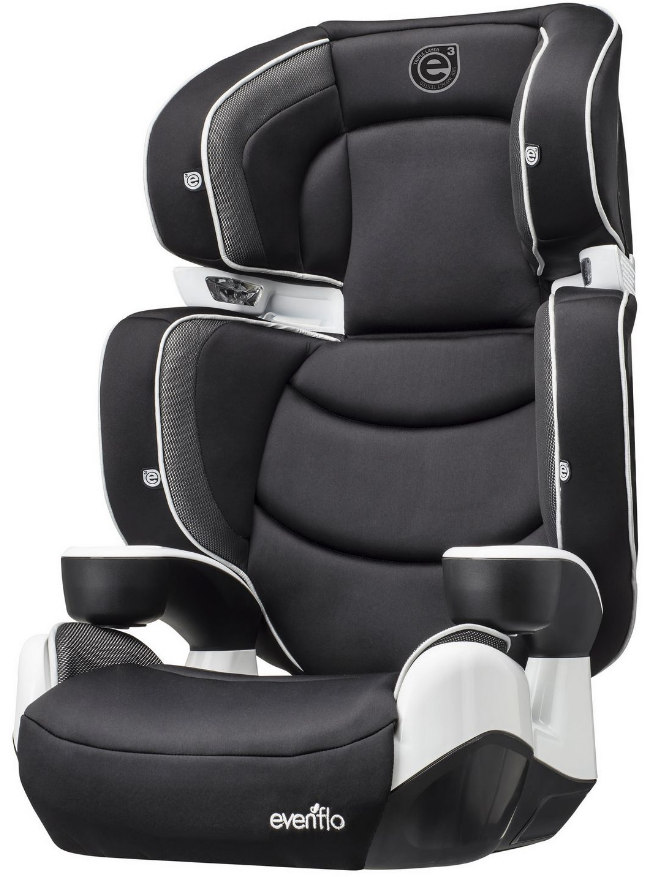
Content
Introduction
The Evenflo Big Kid Right Fit Booster Seat is designed to provide safety and comfort for children transitioning from a harnessed car seat to a booster. Featuring advanced E3 foam technology, it reduces crash forces during side impacts, ensuring enhanced protection. The seat offers multiple height adjustments and cup holders for convenience. It is suitable for children weighing up to 110 pounds and is easy to install in most vehicles. The cost of the Evenflo Big Kid Right Fit Booster Seat is approximately $89.99.
Replacement Parts
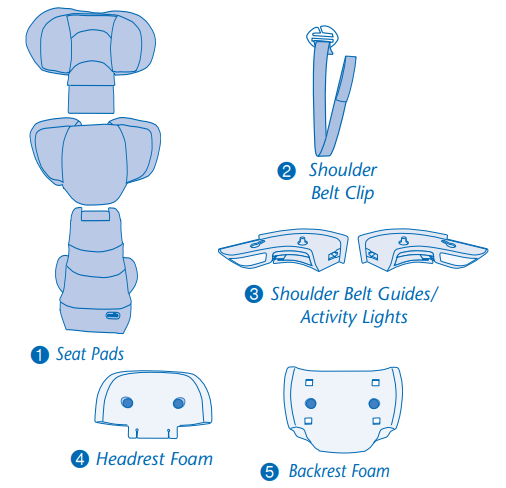
Not available on all models. You can order replacement parts online at https://www.evenflo.com or contact Evenflo at 1-800-233-5921. When you contact us, please have the product model number and date of manufacture (found on the bottom of the child restraint).
Visual Glossary
Your vehicle may appear significantly different than pictured. Consult your vehicle's owner's manual to help identify your vehicle components.
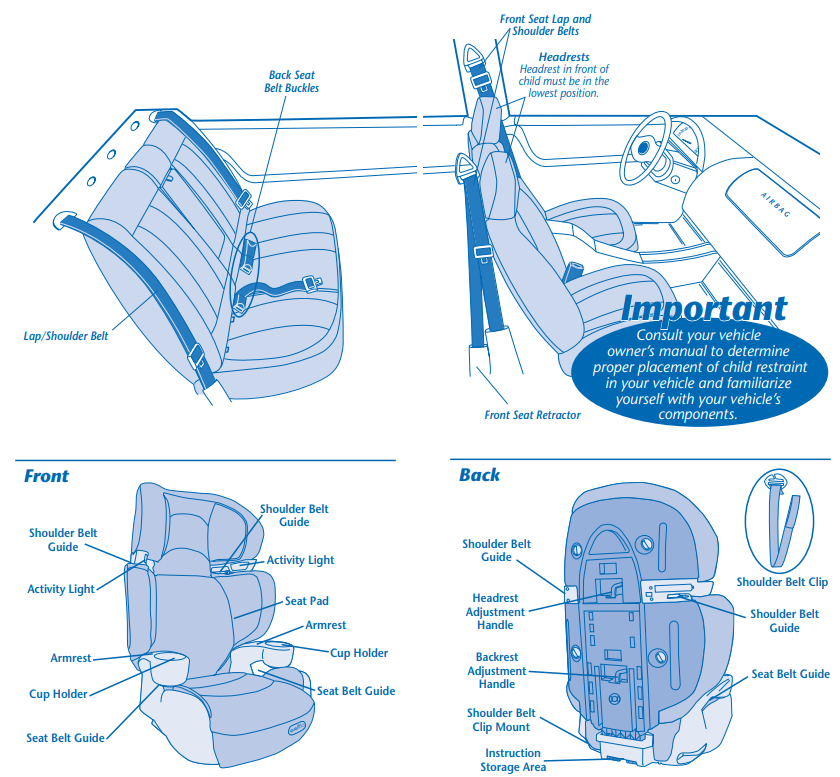
Detailed Specifications
- Weight Range: 40-110 pounds
- Height Range: 38-57 inches
- Seat Belt Fit: Designed to ensure proper fit of the vehicle's seat belt across the child's shoulders and hips
- Comfort Features: Padded seat and backrest for maximum comfort
- Ease of Use: Simple to install and adjust
- Durability: Made with high-quality materials for long-lasting use
- Certifications: Meets or exceeds all applicable U.S. safety standards
Assembling Your Booster Seat
- Install headrest to backrest. Install headrest A into backrest B, as shown. Make sure headrest locks securely into place with an audible click.
- Install seat back connector to backrest. Install seat back connector C into backrest B, as shown. Make sure connector locks securely into place with an audible click.
- IMPORTANT: You MUST assemble the headrest and backrest as instructed before using the backrest assembly.
- Install backrest assembly to seat. Install backrest assembly D into seat E, as shown. Make sure backrest assembly locks securely into place with an audible click.
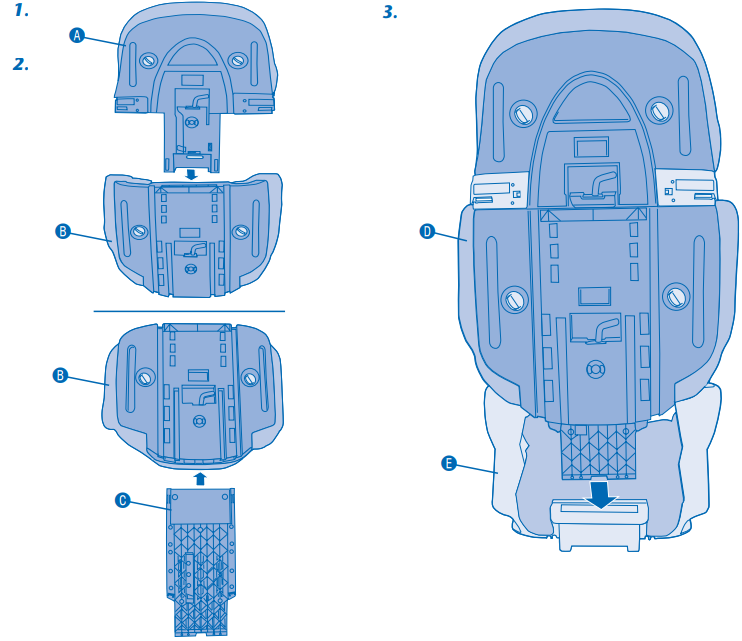
When to Put Your Child in a Booster Seat
Booster seats raise the child up and help to position the vehicle lap and shoulder belt correctly. When the child is properly restrained in a booster seat, his/her risk of injury in all types of crashes is reduced, as the lap and shoulder belt provides excellent restraint of both the upper and lower torsos.
It is important for the child to sit properly within the vehicle seat belts. When the vehicle belt is buckled, the lap belt should be low on the hips, just touching the thighs, and the shoulder belt should lie across the middle of the shoulder. If the child leans out or moves the belt behind the back or places it under the arm, it will not provide the intended restraint. There are a number of things to consider when deciding whether a child is ready to sit in a booster seat, includ- ing: the weight and height ratings on his/her current child seat, the child's own weight and height, his/her maturity, and the seating positions available in your vehicle.
How is a booster seat used?
Using a booster seat is very similar to buckling yourself into the vehicle:
- Read the instruction manuals for both the booster seat and the vehicle before you start.
- Put the booster in the back seat in a location with a lap and shoulder belt. Never use a booster with only a lap belt, as this could cause serious injuries.
- After the child is in the booster, pull the lap and shoul- der belt across him/her and buckle it.
- Check that the shoulder belt lies across the middle of the shoulder and that the lap belt is low on the hips, just touching the thighs.
How can you tell if a child is ready to transition to a booster seat?
You should consider using a booster seat if the following conditions apply:
- The child is mature enough to sit in the booster seat and not put the belts under his/her arm or behind his/ her back.
- The child is approaching the weight or height limit of the child restraint he/she is currently using. (Even children who have not outgrown their toddler seat can benefit from the use of a booster seat, if it is used properly.)
- If you have a vehicle that does not have a tether anchorage but has lap/shoulder belts available in the back seat, a booster seat may provide better protec- tion than an internal harness seat without the tether.

Description
The Evenflo Big Kid Right Fit Booster Seat is crafted with both safety and comfort in mind. The seat features a padded design that provides support and comfort for long car rides. The adjustable headrest ensures a proper fit as the child grows, while the integrated cup holders keep drinks and snacks within easy reach. The booster seat is easy to clean and maintain, making it a practical choice for busy parents.
Using Your Booster Seat with the Backrest
Child Requirements
- Weight: 13.6 to 49.8 kg (30 to 110 lbs)
- Height: 97 to 145 cm (38 to 57 inches)
- Age: At least four years old Ears below top of booster seat headrest

Installation Checklist
- Place the booster seat on the vehicle seat.
- Set the child in the booster seat. Make sure the child's back and bottom are flat against the back and bottom surfaces of the booster seat.
Adjust the backrest and/or headrest of the booster, if necessary. Adjust the backrest and or headrest so the shoulder belt properly lays midway between the child's shoulder and neck (see Adjusting the Backrest, page 16).
WARNING
The shoulder belt MUST NOT cross the child's neck or fall off the child's shoulder. If you cannot adjust the shoulder belt to properly lay midway between the child's shoulder and neck, try another seating location or do not use the booster seat.
- Secure the child and booster seat to the vehicle seat. Stretch the lap/shoulder belt across the child, beneath the armrests, and fasten the buckle. Make certain the shoulder belt is threaded through the shoulder belt guide and at or above the shoulder. If it is below the shoulder, remove the backrest (page 17) and reinstall the booster seat (page 14).
- Check your work. Make sure the lap belt is stretched low and snug across the child's hips, beneath the armrests, and fastened into the buckle. The shoulder belt must cross the child midway between his/her shoulder and neck.
IMPORTANT Always secure the booster seat with the vehicle seat belts when not occupied. An unsecured booster seat can fly into and injure other occupants in the event of a crash.
Using Your Booster Seat Without the Backrest
Child Requirements
- Weight: 18 to 49.8 kg (40 to 110 lbs)
- Height: 102 to 145 cm (40 to 57 inches)
- Age: At least four years old Ears below the top of the vehicle seat headrest

Installation Checklist
- Remove the backrest from the booster seat. (See Removing the Backrest, page 17.)
- Place the booster seat on the vehicle seat.
- Set the child in the booster seat. Make sure the child's back is flat against the vehicle seat and the child's bottom is flat against the booster seat.
- Secure the child and booster seat to the vehicle seat. Stretch the lap/shoulder belt across the child and fasten the buckle.
Use the shoulder belt clip, if necessary. If the shoulder belt does not properly lay midway between the child's shoulder and neck, attach and adjust the belt clip (see Using the Shoulder Belt Clip, page 18).
WARNING The shoulder belt MUST NOT cross the child's neck or fall off the child's shoulder. If you cannot adjust the shoulder belt to properly lay midway between the child's shoulder and neck, try another seating location or do not use the booster seat.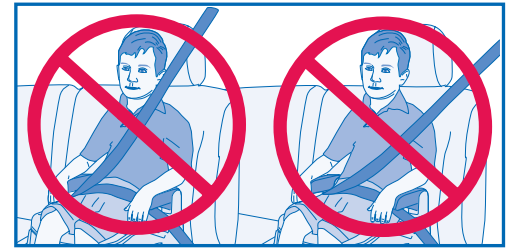
- Check your work.
Make sure the lap belt is stretched low and snug across the child's hips, beneath the armrests, and fas- tened into the buckle. The shoulder belt must cross the child midway between his/her shoulder and neck.
Note: If the vehicle's shoulder belt naturally crosses the child's shoulder, you do not need to use the shoulder belt clip.
IMPORTANT
Always secure the booster seat with the vehicle seat belts when not occupied. An unsecured booster seat can fly into and injure other occupants in the event of a crash.
Adjusting the Booster Seat
IMPORTANT Always adjust the headrest and backrest of the booster seat so that the shoulder belt crosses his or her chest prop- erly (see pages 12 and 14).
Adjusting the Headrest
To adjust the headrest , pull the locking lever B and either raise or lower the headrest.
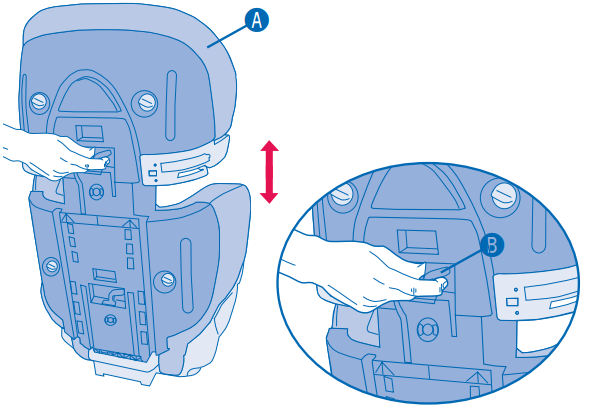
NOTE: The headrest has three adjustment positions.
Adjusting the Backrest
To adjust the backrest C, pull the locking lever D and either raise or lower the backrest. The backrest is positioned properly when the bottom of the shoulder belt guides are even with the top of child's shoulders.
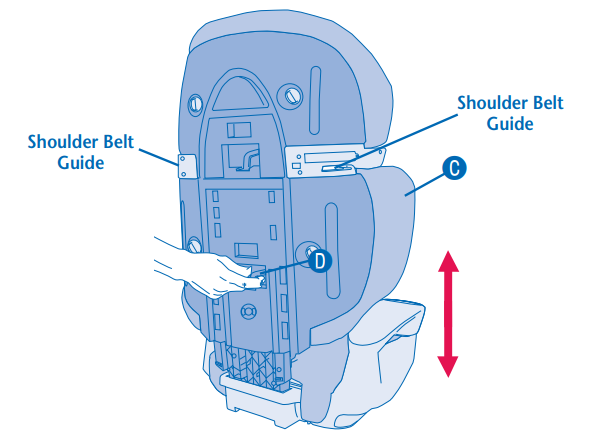
NOTE: The backrest has four adjustment positions.
Removing the Backrest
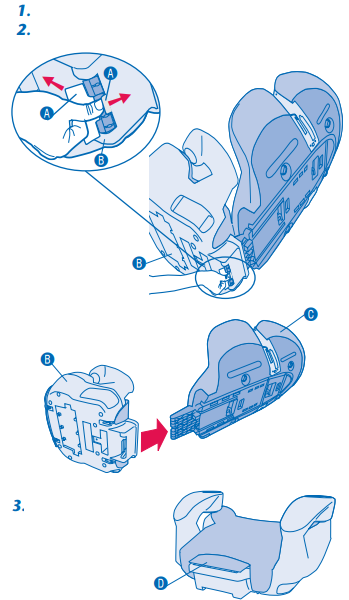
- Lay the booster seat on its side.
- Use your fingers to push apart the lever A on the bottom of the base B, as shown, and remove the backrest C from the base.
- After removing the backrest, position the flap D over the back part of the base, as shown, for comfort.
IMPORTANT Store the backrest properly when not in use. Any loose objects can become projectiles and injure someone during a crash.
Using the Shoulder Belt Clip

- Remove the shoulder belt clip harness A from the storage area B beneath the booster C.
Note: Be sure to remove rubber band around the strap and dispose of properly. - Place booster C on the vehicle seat and attach the shoulder belt clip A to the vehicle shoulder belt D.
- Pull the adjustment strap E until the belt clip A is even with the child's shoulder, and the vehicle shoulder belt D lays across the child's chest midway between his/her shoulder and neck.
- To store the shoulder belt clip harness, fold it and place it in the storage area B
Using the Accessories
Not available on all models.
WARNING
- DO NOT use the cup holder to store cans or hard cups. Only for use with soft cups (such as styrofoam or paper).
- DO NOT place any cups that contain hot liquids (such as coffee or tea) in the cup holder.
- DO NOT snap any other items to this booster seat unless it has been certified for use with this specific booster seat.
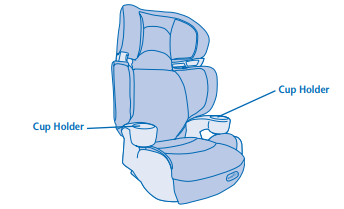
Using the Activity Lights
Not available on all models. Press either of the two activity light lens * on each side of the headrest to turn on or off.
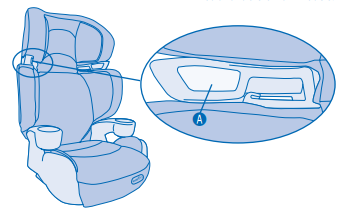
Replacing the Batteries
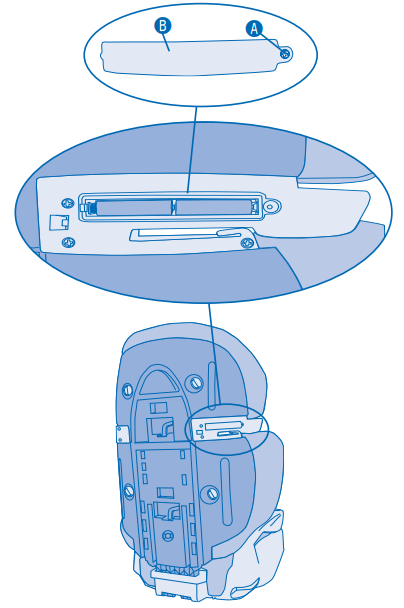
- To replace the batteries for either the left or right activity light, loosen screw A and battery carrier B from seat back. Install two fresh AAA batteries, as shown.
NOTE: Dispose of old batteries properly.
WARNING: DO NOT mix aldine, timba, standard (carbon-zine), or rechargeable (nickel-cadmium) batteries. - Remove batteries before storing unit for a prolonged period of time.
Replacing the Batteries
- To replace the batteries for either the left or right activity light, loosen screw ® and battery carrier ® from seat back. Install two fresh AAA batteries, as shown. NOTE: Dispose of old batteries properly.
- WARNING: DO NOT mix alkaline, livy ha, sriedard (carbon-zine), or rechargeable (nickel-cadmium) batteries.
- Remove batteries before storing unit for a prolonged period of time.
Removing the Cushions
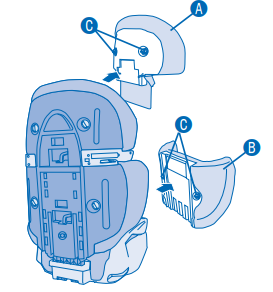
To remove the headrest cushion A and the backrest cushion B, loosen the locks C by turning counterclockwise. If desired, remove pads from the headrest and backrest foam. To install cushions, reverse this procedure.
Storing Your Instructions

After thoroughly reading and following these instructions, STORE THE INSTRUCTIONS IN THE SLOTS PROVIDED ON THE BOTTOM OF THE BOOSTER SEAT.
Proper Disposal of This Child Restraint
At the end of this child restraint's useful life, Evenflo encourages you to dispose of it properly. Most of the components in this child restraint are recyclable.
- Remove all fabric and padding.
- Remove all screws and disassemble the restraint.
- Recycle all plastic/foam parts and discard the rest. If your local recycling center won't accept the padding, you may dispose of it in the landfill.
Note: Evenflo uses recycled materials in the manufacturing process whenever possible but never for components that are critical for safety.
Setup Guide
- Unboxing and Preparation:
- Carefully remove the booster seat from the packaging.
- Ensure all parts are included and undamaged.
- Placement in Vehicle:
- Position the booster seat on the vehicle's seat, ensuring it is centered.
- Adjust the headrest to the correct height for your child.
- Adjusting the Seat Belt:
- Guide the vehicle's seat belt across the child’s body, ensuring it fits snugly across the shoulders and hips.
- Adjust the booster seat as necessary to achieve a proper fit.
- Securing the Child:
- Buckle the child into the seat belt, making sure it is not twisted or bunched up.
- Check that the shoulder strap lies across the child’s shoulder and chest.
Important Instructions
More children are killed every year as passengers in car crashes than by any other type of injury. To reduce the risk of SERIOUS INJURY or DEATH, read this owner’s manual and your vehicle owner’s manual before installing and using this child restraint. Using a child restraint makes a big difference. By properly using this child restraint and following these instructions (and the instructions that accom-pany your vehicle), you will greatly reduce the risk of serious injury or death to your child from a crash. Do not be misled by the commonly used term “safety seat;” no restraint system can prevent all injuries in all crashes. Many properly restrained adults and children are injured in motor vehicle crashes, including relatively minor crashes. A properly used child restraint is the best way to minimize injuries to your child and to increase the chances for your child’s survival in most crashes.
Child Requirements
- No child restraint can guarantee absolute protection from injury in every crash.
- To use this child restraint properly, children MUST meet weight/size specifications as follows:
With Backrest
- Symbol Legend
Airbag Symbol - Alerts you to important
information about airbag safety.
A WARNING
Without Backrest
- 18 to 49.8 kg (40 to 110 lbs)
- 102 to 145 cm (40 to 57 inches) tall
- Child is at least four years old.
- Ears below top of vehicle seat headrest.
Symbol Legend
Airbag Symbol - Alerts you to important information about airbag safety.
WARNING
General Warnings
- Failure to follow each of the following instructions can result in your child striking the vehicle's interior during a sudden stop or crash, potentially resulting in serious injury or death. These instructions and the instructions in your vehicle owner's manual must be followed care- fully. If there is a conflict between the two, the vehicle owner's manual regarding booster seat installation must be followed.
- NEVER leave child unattended.
- In addition to the height and weight requirements, your child must be at least four years old to use this booster seat.
Airbags Warning
- DO NOT use this restraint in the front seat of a vehicle equipped with an air bag, unless the air bag has been deactivated. Air bags may cause serious injury or death to children 12 and under. If your vehicle has an air bag, refer to your vehicle owner's manual for child restraint installation.
- If the rear seat of your vehicle is equipped with side air bags:
- Vehicles built prior to the 2002 model year: DO NOT use this restraint in a vehicle seating position equipped with a side air bag unless authorized by the vehicle manufacturer.
- Model year 2002 and newer vehicles: Refer to your vehicle owner's manual before placing this restraint in a seating position equipped with a side air bag. DO NOT place any objects between the restraint and the side air bag, as an expanding air bag may cause the items to strike your child.
IMPORTANT: The back seat is the safest place for children 12 and under.

Location Warnings
- According to statistics, children are safer when properly restrained in a rear seating position than in the front seating position. Children 12 and under should ride in the back seat of the vehicle.
- Use this booster seat only on forward-facing vehicle seats. DO NOT use this booster seat with vehicle seats that face the rear or side of the vehicle.
- Use this booster seat only on vehicle seats with backs that lock into place.
- Some booster seats do not fit in all vehicles. If the booster seat cannot be properly installed, DO NOT use the booster seat.
Troubleshooting
- Seat Belt Not Fitting Properly:
- Check if the headrest is adjusted correctly.
- Ensure the booster seat is placed properly on the vehicle's seat.
- Child Not Comfortable:
- Adjust the headrest and seat position to better fit the child.
- Use additional comfort items like pillows or blankets if necessary.
- Difficulty Installing:
- Refer to the user manual for detailed installation instructions.
- Contact customer support if issues persist.
Instructions and Warnings:
- Always follow the manufacturer's instructions for installation and use.
- Never use this booster seat without properly securing the child with the vehicle's seat belt.
- Regularly inspect the booster seat for any signs of damage or wear.
Evenflo Big Kid Right Fit Booster Seat Warranty
For a period of 90 days from the original purchase of this Product, Evenflo warrants to the original end user ("Purchaser") this Product (including any accessories) against defects in material or workmanship. Evenflo's sole obligation under this express limited warranty shall be, at Evenflo's option, to repair or replace any Product that is determined to be defective by Evenflo and determined to be covered by this warranty.
Pros & Cons
Pros
- Adjustable Headrest: Allows for easy adjustments as the child grows.
- Comfortable Design: Padded seat and backrest provide long-lasting comfort.
- Ease of Installation: Simple and straightforward setup process.
- Affordable: Priced competitively compared to other booster seats on the market.
- Integrated Cup Holders: Convenient storage for drinks and snacks.
Cons
- Limited Customization: Some users may find limited options for customization.
- Bulkier Than Some Alternatives: May take up more space in smaller vehicles.
- Cleaning Can Be Challenging: Some users report difficulties in cleaning certain parts of the seat.
Customer Reviews
The Evenflo Big Kid Right Fit Booster Seat has received positive reviews from many parents who appreciate its ease of use, comfort, and safety features. However, some users have noted that cleaning the seat can be a bit challenging and that it may be bulkier than other options available.
Most Common Complaints
- Difficulty in cleaning certain parts of the seat.
- Bulkier design compared to other booster seats.
Faqs
What is the weight range for the Fit Booster?
How do I adjust the headrest on the Evenflo?
Can I use this booster seat in any vehicle?
How do I know if my child is ready for a booster seat like this one?
Is the Evenflo Big Kid Right Fit certified for safety?
How often should I inspect my booster seat for signs of wear or damage?
Can I use this Evenflo Big Kid Right Fit Booster Seat in both back and front seats of my vehicle?
What materials are used in making the Evenflo Big Kid Seat?
Leave a Comment
